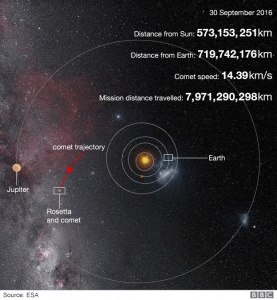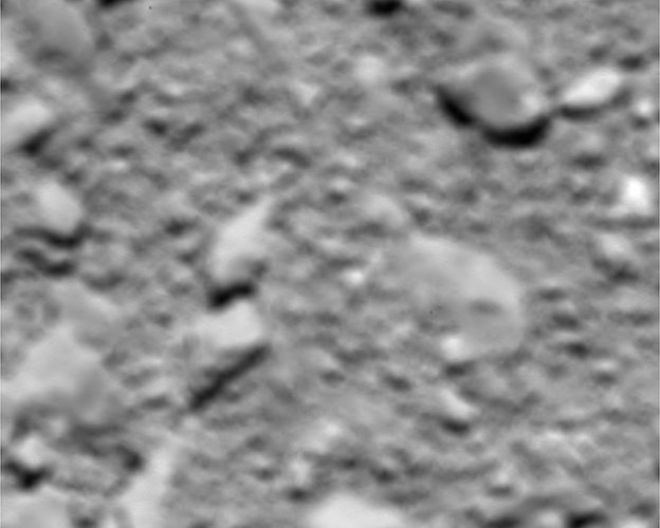Europe’s Rosetta probe has ended its mission to Comet 67P by crash-landing on to the icy object’s surface.
Mission control in Darmstadt, Germany, was able to confirm the impact had occurred when radio contact to the ageing spacecraft was lost abruptly.
The assumption is that the probe would have been damaged beyond use.
In the hours before the planned collision, Rosetta sent back a host of high-resolution pictures and other measurements of the icy dirt-ball.
“I can announce full success of this historic descent of Rosetta towards Comet 67P,” said European Space Agency mission manager Patrick Martin.
“Farewell Rosetta; you’ve done the job. That was space science at its best.”
Researchers expect all the data gathered at 67P in the past two years to keep them busy for decades to come.
The loss of signal, when it happened, was greeted by muted cheers and handshakes – not too surprising given the bittersweet nature of the occasion.
Some of the scientists watching on here in Darmstadt have spent the better part of 30 years on this project.
“People are very sad today but I think they really understand how proud we are and how proud they should be that we’ve pulled this mission off,” said Esa’s senior science advisor, Mark McCaughrean.
The loss of signal, when it happened, was greeted by muted cheers and handshakes – not too surprising given the bittersweet nature of the occasion.
Some of the scientists watching on here in Darmstadt have spent the better part of 30 years on this project.
“People are very sad today but I think they really understand how proud we are and how proud they should be that we’ve pulled this mission off,” said Esa’s senior science advisor, Mark McCaughrean.
Throughout Friday morning, the instrument teams had followed every twist and turn as the probe aimed for a touchdown spot on the head of the 4km-wide, duck-shaped comet.
The researchers had wanted the descending probe to get a look inside one of the many pits that pockmark the surface.
These sinkholes are often the places where 67P ejects gas and dust into space. But they also afford an opportunity to look at the object’s interior, to see the lumpy ice blocks that may have come together to build the comet billions of years ago.
Some of the images that came back were acquired just seconds before the collision. These pictures will have resolutions that can be measured in millimetres. “They’re super-duper,” enthused Holger Sierks, the head of the Osiris camera team. “I’ve got goosebumbs just thinking about all this,” he told BBC News.

Comet 67P/Churyumov-Gerasimenko is currently heading away from the Sun, limiting the solar energy available to Rosetta to operate its systems.
Rather than put the probe into hibernation or simply let it slowly fade into inactivity, the mission team determined that the venture should try to go out with a bang.
European Space Agency project scientist Matt Taylor said that even if Rosetta was sent to sleep with the intention of waking it up again when 67P next visited the brighter environs of the inner Solar System – there was no guarantee the technology would still be working properly.
“It’s like one of those 60s rock bands; we don’t want to have a rubbish comeback tour. We’d rather go out now in true rock’n’roll style,” he said just before landing.
Because Rosetta was not designed to touchdown, some of its structures very likely broke on contact with the comet. Controllers left no room for doubt in any case by pre-loading a software sequence that would jump the computers into a shutdown when the probe felt the impact jolt.

